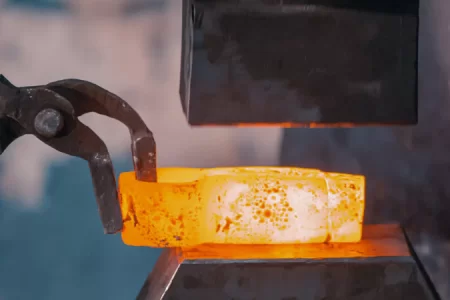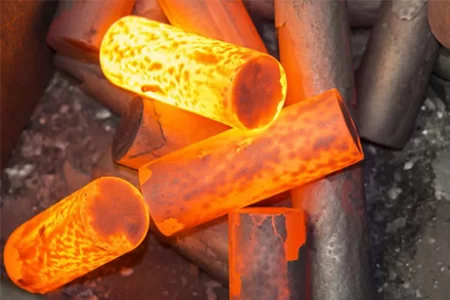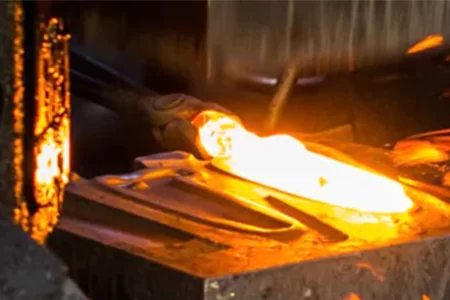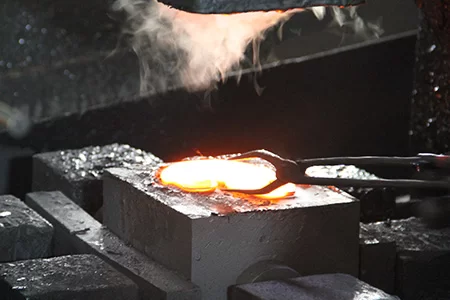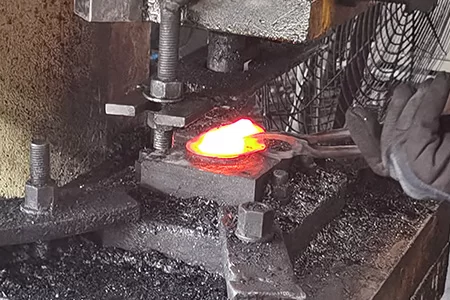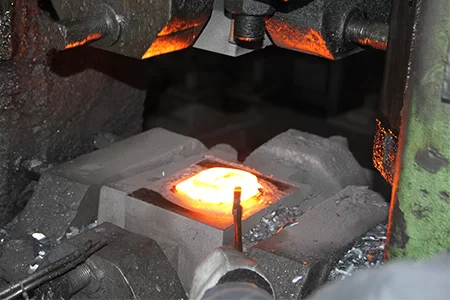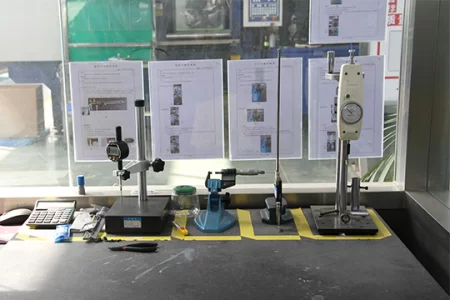By sharing knowledge, experience and views in the field of forging technology, we help you understand, learn and apply relevant technologies.

Hulk Metal Forging Technology
Share technical experience
-
Home>
-
Blog>
-
Technology>
Why Forged Lifting Hooks Are Essential for Safe and Efficient Rigging

In industries where heavy lifting is routine—such as construction, shipping, and manufacturing—the reliability of lifting equipment is paramount. Among these, lifting hooks play a crucial role in ensuring safe and efficient operations. Forged lifting hooks, in particular, are renowned for their strength and durability, making them a preferred choice for demanding applications. This guide delves into the intricacies of forged lifting hooks, exploring their manufacturing process, advantages, applications, and considerations for selection.
What Are Forged Lifting Hooks?
Forged lifting hooks are components designed to bear substantial loads during lifting operations. The forging process involves shaping metal using localized compressive forces, typically delivered by a hammer or die. This method enhances the mechanical properties of the metal, resulting in hooks that are stronger and more reliable than those produced by casting or machining.
The forging process aligns the metal's grain structure, improving its strength and resistance to fatigue. This makes forged hooks particularly suitable for critical applications where safety is non-negotiable.
The Forging Process of Lifting Hooks
The production of forged lifting hooks involves several meticulous steps to ensure optimal performance:
Material Selection: High-quality steel, such as carbon or alloy steel, is chosen based on the required strength and toughness.
Heating: The steel is heated to a specific temperature to make it malleable for forging.
Forging: The heated steel is shaped into the desired hook form using dies and hammers, aligning the grain structure for enhanced strength.
Heat Treatment: Post-forging, the hooks undergo heat treatment processes like quenching and tempering to achieve the desired hardness and toughness.
Machining: Precision machining ensures the hooks meet exact dimensional specifications.
Surface Treatment: Processes such as shot blasting and painting are applied to improve surface finish and corrosion resistance.
Quality Inspection: Rigorous inspections, including ultrasonic and magnetic particle testing, are conducted to detect any internal or surface defects.
This comprehensive process ensures that each forged lifting hook meets stringent quality and safety standards.
Key Features and Advantages of Forged Lifting Hooks
Forged lifting hooks offer several advantages over their cast or fabricated counterparts:
Superior Strength: The forging process enhances the mechanical properties of the metal, resulting in hooks capable of withstanding higher loads.
Enhanced Durability: Forged hooks exhibit better resistance to wear and fatigue, extending their service life.
Improved Safety: The uniform grain structure reduces the likelihood of fractures, ensuring safer lifting operations.
Customization: Forging allows for the production of hooks in various shapes and sizes to meet specific application requirements.
Cost-Effectiveness: The durability and longevity of forged hooks can lead to lower replacement and maintenance costs over time.
Applications of Forged Lifting Hooks
Forged lifting hooks are integral to numerous industries and applications:
Construction: Used in cranes and hoists for lifting heavy materials and equipment.
Shipping and Maritime: Essential for cargo handling and securing loads on ships.
Manufacturing: Facilitate the movement of heavy components and machinery within production facilities.
Mining: Assist in the transportation of mined materials and equipment.
Oil and Gas: Utilized in the handling of pipes and other heavy equipment in offshore and onshore operations.
Their versatility and reliability make forged lifting hooks a staple in any operation requiring the secure handling of heavy loads.
How to Choose the Right Forged Lifting Hook
Selecting the appropriate forged lifting hook involves considering several factors:
Load Capacity: Ensure the hook's rated capacity exceeds the maximum load it will handle.
Hook Type: Choose from various types such as eye hooks, clevis hooks, or swivel hooks based on the specific application.
Material: Select a hook made from a suitable material (e.g., alloy steel) for the operating environment.
Standards Compliance: Verify that the hook meets relevant industry standards and certifications.
Safety Features: Consider hooks with additional safety features like latches or locks to prevent accidental disengagement.
Consulting with manufacturers or suppliers can provide further guidance to ensure the selected hook meets all operational requirements.
Why Choose HULK Metal as Your Lifting Hook Supplier
HULK Metal stands out as a premier supplier of forged lifting hooks, offering:
Expertise: Years of experience in metal forging and a deep understanding of lifting applications.
Quality Assurance: Strict adherence to quality control processes, ensuring each product meets high standards.
Customization: Ability to produce hooks tailored to specific customer requirements.
Comprehensive Services: From design and manufacturing to after-sales support, providing a seamless customer experience.
Global Reach: Capacity to supply products to clients worldwide, ensuring timely delivery and support.
Testing and Quality Control for Forged Lifting Hooks
In critical lifting operations, failure is not an option. That’s why forged lifting hooks must undergo strict quality control procedures before they are delivered to end users. Leading manufacturers like HULK Metal implement multiple layers of testing to ensure their hooks meet and exceed international safety and performance standards.
Common Testing Procedures Include:
Visual Inspection: To identify surface cracks, scale, or forging laps.
Dimensional Inspection: Using precision tools to verify all measurements against design specifications.
Magnetic Particle Testing (MT): Non-destructive test to detect surface and slightly subsurface discontinuities.
Ultrasonic Testing (UT): To uncover internal flaws such as voids, inclusions, or incomplete fusion.
Load Testing: Each batch is often subjected to proof load tests—usually 2 times the Working Load Limit (WLL)—to confirm actual lifting capacity.
Chemical Analysis: Ensures the material composition matches the specified alloy grade.
These quality checks help ensure every lifting hook is safe, reliable, and ready for service in the most demanding applications.
Standards and Certifications for Forged Lifting Hooks
To ensure safety and interoperability, forged lifting hooks must conform to internationally recognized standards. HULK Metal manufactures its hooks in compliance with the following key standards:
EN 1677: European standard for components for slings, including hooks.
CE Marking: Ensures compliance with EU safety, health, and environmental requirements.
TÜV / SGS Certification: Independent third-party certifications for quality and performance.
By adhering to these standards, forged hooks are assured to meet global safety and durability requirements—whether used in Europe, North America, or other markets.
Forged Hook Types and Their Applications
Different lifting operations demand different types of hooks. HULK Metal can manufacture a wide range of forged lifting hook types:
Hook Type | Description | Application |
Eye Hook | Single looped top for chain or rope connection. | General lifting and rigging. |
Clevis Hook | U-shaped clevis with a pin, ideal for easy attachment. | Towing, load securing, and hoisting. |
Swivel Hook | Rotates 360° to prevent twisting of the lifting line. | Crane lifting and offshore applications. |
Self-Locking Hook | Automatically locks when the load is applied. | Safety-critical operations. |
Foundry Hook | Wide throat opening without a latch. | Lifting large and heavy mold parts. |
Each type has specific design features tailored to different operational environments, and HULK Metal offers full customization to meet industry-specific demands.
Common Materials Used in Forged Hooks
Material choice is essential to guarantee strength, wear resistance, and durability. Some common materials used in forged lifting hook production include:
High Carbon Steel (C45, C60): Cost-effective and widely used for moderate-load applications.
Alloy Steel (42CrMo, 34CrNiMo6): Offers high tensile strength and toughness, suitable for heavy-duty lifting.
Stainless Steel (304/316): Excellent corrosion resistance, ideal for marine or chemical environments.
HULK Metal selects materials based on customer application, working conditions, and load specifications to ensure each product performs as expected.
Surface Treatment Options
Forged lifting hooks are often exposed to harsh environmental conditions. To enhance corrosion resistance and aesthetic appeal, surface treatments are applied:
Hot-Dip Galvanizing: Long-term corrosion resistance, ideal for outdoor or marine environments.
Powder Coating: Available in various colors; offers protection and branding flexibility.
Zinc Plating: Provides basic rust resistance and smooth finish.
Black Oxide: Used for industrial applications, offering mild corrosion protection.
These coatings not only extend service life but also support safety (e.g., color-coding for load capacities).
Real-World Case Studies
Case 1: Heavy Construction Equipment Handling
A construction firm in Australia required forged hooks capable of lifting 20-ton excavator components. HULK Metal delivered custom-engineered clevis hooks made of 34CrNiMo6 alloy, heat-treated for high impact resistance. After six months of usage, the client reported zero hook-related failures, enhancing on-site efficiency and safety.
Case 2: Offshore Oil Rig Operations
An oil & gas client in the Middle East faced issues with corroded hooks in salty environments. HULK Metal supplied forged stainless-steel swivel hooks with anti-rust coatings. The result? Lifespan increased by 3X and downtime for replacements was significantly reduced.
These cases show how customized forging solutions solve real-world challenges and help clients achieve better performance and ROI.
Contact us today to get a quote or consultation on your next lifting hook order. Let’s forge strength and safety—together.
Forged lifting hooks are more than just metal parts—they are safety-critical components that bear the weight of your entire operation. With enhanced mechanical strength, customizable designs, and a superior safety record, forged hooks remain the top choice for demanding lifting and rigging applications.
By choosing a reliable and experienced supplier like HULK Metal, you ensure your business benefits from high-performance components backed by industry expertise and uncompromising quality.
Article Navigation
Article Navigation
Foundries
-

July.01, 2024
Difference between hot forging and cold forging
READ MORE
-

June.27, 2024
What are the advantages and disadvantages of the hot forging process?
READ MORE
-

January.18, 2024
Forging: What Is It? What Are The Different Types of Hot Forging?
READ MORE
-

February.28, 2025
Open Die Forging: Exploring the forging process and the key factors in selecting a OEM
READ MORE
-

February.24, 2025
Key Considerations for Closed Die Forging
READ MORE
-

February.18, 2025
Factors to consider when purchasing custom forgings
READ MORE
-

February.14, 2025
HULK Metal's hot forging quality control
READ MORE



